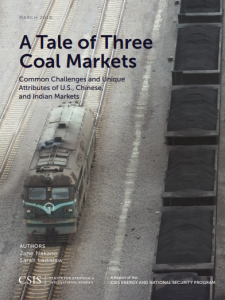Full Title: A Tale of Three Coal Markets
Author(s): Jane Nakano and Sarah Ladislaw
Publisher(s): CSIS Energy and National Security Program
Publication Date: March 1, 2018
Full Text: Download Resource
Description (excerpt):
The United States, China, and India together constitute about 70 percent of global coal consumption and 64 percent of global coal production. Each country is an important contributor to the global coal supply and demand picture and yet each stands at a very different stage in its relationship with coal.
The history of coal in the United States is predicated on a long-term decline in its share of the electricity fuel mix, but deep regional socioeconomic ties give the fuel an outsized role in national energy politics. Coal makes up 15 percent of the total U.S. energy mix and 30 percent of the electric power mix while the power sector accounts for about 90 percent of coal use in the United States. Over the years, electricity demand has flattened thanks to strong efficiency gains. Moreover, the abundance of inexpensive natural gas and rapid decline in renewable energy costs have significantly diminished the competitiveness of coal-fired power generation. Unlike in China and India, the U.S. coal fleet is in contraction as a wave of retirements is underway, with little evidence of reversal, indicating that the current downturn appears structural and not cyclical. After a recent period of decline and bankruptcy for the U.S. industry, a political movement to revitalize the coal sector has emerged from the current presidential administration. Notwithstanding the renewed political support, however, the regulatory uncertainty clouds a future pathway for a coal power resurgence. The notion of economic and energy security benefits long associated with the use of coal has effectively disappeared in one of the largest producer and consumer markets for coal in the world.
